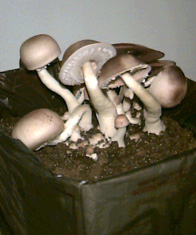

Yes. Although straw contains peroxide-decomposing enzymes that will rapidly do away with any peroxide you add, my recent experiments show that straw (and presumably other similar drainable substrates), as well as pelletized straw, can be prepared very easily by room temperature methods using peroxide, despite the enzymes. The most recent procedures for whole straw are incorporated into Volume II of the manual.
There is little use for peroxide in preparation of compost. This is because compost is by nature not a sterile substrate. Properly made compost should have a tremendous diversity of microorganisms in it, even after it heats up to temperatures high enough to kill insects and weed seeds. This diversity of microoganisms should protect the mushrooms from molds and pathogens. The appearance of significant mold growth during the colonization of compost by mushroom tissue is a likely sign that the compost lacks an important set of microorganisms, perhaps because it was allowed to get too hot. Although one might be able to control such mold or pathogen growth with peroxide, a better solution is to correct the procedure for compost preparation. See Dr. Elaine Ingham's fascinating website, Soilfoodweb.com for more information on what makes good compost.
If compost (or straw) is your preferred substrate, however, you can still use peroxide to maintain agar cultures and prepare spawn.
In addition, most mushrooms that grow on straw or compost will also grow on wood pellet fuel or similar peroxide-compatible materials prepared by the peroxide method (as are the almond mushrooms shown above) although the overall yield may be lower for some species.
You can use straw and similar drainable materials, wood chips, and nut and seed hulls (details in Volume II of the manual), or certain peroxide-compatible porous woody materials, such as wood pellet fuel (sawdust made into hard dry pellets), pelleted straw, sawdust-based cat litter (in the UK, Fussy Puss™ litter), additive-free composite logs (in the UK, Clean Heat™ logs), the sawdust derived from milling of kiln-dried lumber (oyster mushrooms only), paper fiber pellets (in the US, Crown™ Animal Bedding or Good Mews™ Cat litter), paper pulp, and clean cardboard. Any other porous substrate commonly used for mushroom growth, such as raw sawdust, will work with peroxide if you first pressure-sterilize the substrate to destroy the peroxide-decomposing enzymes present in it.
This document is Copyright: ©2000 by Randall R. Wayne, Ph.D. All commercial rights are reserved. No part of this work may be reproduced or used for sale in any form or by any means without permission of the author.